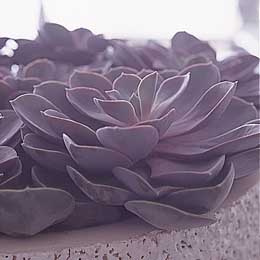 |
Echeveria
Name - Pronounced e-CHEV-er-ee-a. It is named after Anthanasia Echeverria
Godoy, a botanical artist who accompanied the expedition under Sessé and
Mociño to Mexico between 1787 and 1797. Description - Echeveria
is a succulent which comes in a variety of forms, with many different common names.
It usually has rosettes of fleshy leaves which flower in spring, summer or winter
depending on species. Echeveria multicaulus (or Mexican rose) produces red and
yellow flowers in winter.
Origin - Mexico, South America
Family - CrassulaceaeVarieties - There are countless
varieties and hybrids available, with green and brownish-red, often hairy or frosted
leaves. Among the best known are Echeveria derenbergii (painted lady) and Echeveria
agavoide (moulded wax plant) and Echeveria glauca (blue echeveria).Care
Tips - Like most succulents, it likes plenty of sunshine. Easy to care for
and ideal as a houseplant, it needs moderate amounts of water during the growing
period. It is best to water the plant from the bottom or stand in a saucer of
water for about an hour, to moisten the compost. Dampness kills the plant. Spread
a layer of coarse sand or gravel over the surface of the compost to protect the
rosette-forming Echeveria from rotting.
Trivia - Echeverias
can be propagated from seed and by taking leaf cuttings or offsets. They are ideal
for planting in miniature gardens with other small succulents and cacti.

back |
|
|

